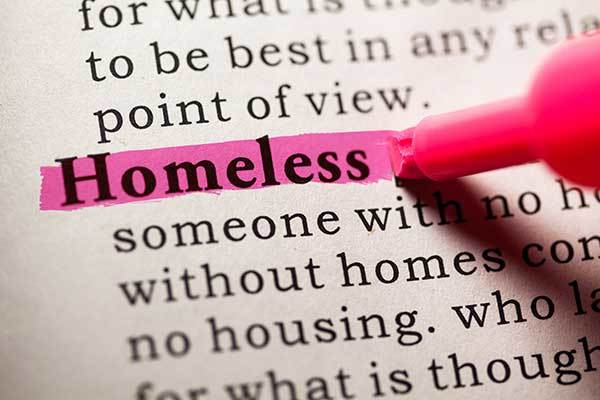You are viewing 1 of your 1 free articles
The Homelessness Reduction Act: how councils are responding
New legislation placing homelessness prevention duties on councils has been in place for several months. Sophie Barnes finds out how two councils have changed the way they work as a result
In the busy foyer of Leeds Council’s brand new offices, a young man barely out of his teenage years shuffles over to staff. “Are you alright, Liam?” asks one of the housing officers. “Not really, no. I’m being harassed,” he replies.
The officer, clearly familiar with Liam’s situation, takes him off to one side for a more private chat. It may not be immediately obvious to Liam, but huge changes have recently taken place behind the scenes in the council’s homelessness services.
The Homelessness Reduction Act was brought into law mere months ago, and for some councils it has transformed the way they work.
The act places an important responsibility on councils to prevent homelessness, rather than tackle it when someone has already found themselves without a permanent home.
Councils have to help certain people facing homelessness to stay in a tenancy or find somewhere else to live. This process lasts 56 days.
“Now everyone approaching a council should be given homelessness support”
Whereas previously councils would only have to offer temporary accommodation to people considered to be in priority need – such as families, pregnant women and minors – now everyone approaching a council should be given homelessness support and at the very least signposted to services that can help.
This means young men like Liam are more likely to get personalised support when they walk into a council office, rather than a brush-off. But what does this mean for the workload of homelessness staff?
Inside Housing takes a look at two very different councils to find out. Funding questions Rob McCartney, head of housing support at Leeds Council, says he had some “trepidation” over whether the ‘new burdens’ funding that the council has received from government funding would stretch to help a whole new influx of people covered by the new law – but so far it’s been a positive shift (Leeds has been allocated £561,071 over three years out of £72.7m given to English councils).
“I think the obligation to develop personal housing plans [and] 56-day prevention and relief duty raises the profile of the housing options function. In a sense it professionalises housing advice services.”
He adds: “Clearly there’s more work to do than previously because now the likely trigger is eligibility rather than priority need, and so people who may not have received such a comprehensive service under the previous legislation, now we have that 56-day duty to prevent and relieve homelessness. That’s a good thing.”
The council has let Inside Housing sit in on a homelessness assessment to see what this personalised support looks like.
A mother and her three-year-old sit waiting for their 2pm appointment. The mother has a black plastic bag filled with papers including her passport and those of four of her children.
Her three-year-old, the only one in the family without a passport, plays with the tough covers – turning them over in her hands.
The woman and her daughter – their names kept anonymous for this article – have come to the council because the family wants to return to the Czech Republic but her threeyear-old doesn’t have a passport.
On the morning before Inside Housing meets them, they were greeted with an eviction notice through their front door.
The family had been living with a friend, and when he moved out of his private rented tenancy, they stayed. But they didn’t pay rent.
In the brief notice, the landlord tells them in no uncertain terms that they are “illegally squatting” and if they’re not out by 6pm that evening they will take legal action.
The family now need somewhere to stay while they wait for the youngest child’s passport to arrive.
The mother has been in the UK for more than two years, but isn’t currently working because she’s looking after her three-year-old. The youngest child was the only one born in the UK but she’s not at nursery.
This means she’s not eligible for help from the council with finding housing because her only daughter born in the UK is not in education and she is not in work.
Because she isn’t eligible, the housing options service doesn’t have a duty to house her but the officers set up a private rented house for her to stay in over the weekend.
An officer calls a taxi and arranges for her to be taken back to the house she has been evicted from, pick up all her belongings and take them to the temporary accommodation.
Her four older children are still at school, so the officer tells her she will have to arrange for someone to collect them and bring them to the new house.
With its ‘new burdens’ funding brought in to support implementation of the legislation, Leeds Council has introduced daily training sessions on homelessness law and recruited some more team leaders for the housing advice service.
Mr McCartney says he felt the key to responding to the new act “was not volume of staff but the quality of decision-making”. From Mr McCartney’s point of view, the act doesn’t represent a monumental shift in the way the council goes about helping people.
“We weren’t an authority saying ‘we’ve got no temporary accommodation duty to you, therefore we advise you to go away and save up for a bond’ – it’s never been like that.
So it hasn’t been maybe the big jump that’s occurred in other authorities. Our prevention rates were around 82% last year.”
The council also benefits from a large amount of housing stock under its management. But what about councils in areas facing the highest homelessness pressures in the country?
Inside Housing spoke to a senior leader at Southwark Council, one of the busiest homelessness departments in the country, to find out.
Southwark was the only local authority in England to fully pilot the Homelessness Reduction Act in advance of its nationwide roll-out in April, changing its working patterns from October 2016.
For Stephanie Cryan, cabinet member for housing management and modernisation, the biggest challenge was a “culture shift – how the act really put the onus on [us to be] helping everybody, even if it’s just signposting”.
While it may have been a jolt to the system, Ms Cryan says the team feels the way it works now “is so much etter because of the act”. “It allows the team to give a better service to people coming through the door and to tailor the service to everyone’s individual needs,” she says.
“Previously it was ‘computer says no’. Do you meet the criteria? Computer says yes. This is more about working with somebody through their individual circumstances and supporting them in whatever way is needed.
“What we now do is we might say, ‘We can’t house you as a council but what we can do is help you find accommodation – so we can look in the private rented sector, we can give you help and support and [find] which partner organisations can help and work with them on the personalised housing plan.’”
At a glance: Homelessness Reduction Act 2017
The Homelessness Reduction Act 2017 came into force in England on 3 April 2018.
The key measures:
- An extension of the period ‘threatened with homelessness’ from 28 to 56 days – this means a person is treated as being threatened with homelessness if it is likely they will become homeless within 56 days
- A duty to prevent homelessness for all eligible applicants threatened with homelessness, regardless of priority need
- A duty to relieve homelessness for all eligible homeless applicants, regardless of priority need
- A duty to refer – public services will need to notify a local authority if they come into contact with someone they think may be homeless or at risk of becoming homeless
- A duty for councils to provide advisory services on homelessness, preventing homelessness and people’s rights free of charge
- A duty to access all applicants' cases and agree a personalised plan
The focus on prevention in the legislation has completely changed the way the council operates, according to Ms Cryan. “There are lots of different ways of working now, which we didn’t do previously. Some of the stuff we’re using are Discretionary Housing Payments to help secure properties for people in the private rented sector.
It’s a totally different way of working; it isn’t the old way where we’d say ‘sorry we can’t help you, we don’t have a statutory duty, off you go’.
“Now [we say] ‘we may not have a statutory duty but we do have an obligation to support you to find ways of finding somewhere for you’ and it might not be a council property – in fact it probably won’t be – but there are ways we can help them.”
But however much council officers talk up their focus on the individual, there are limited options open to someone facing homelessness in central London, who is without a high income and who relies on benefits.
Under pressure Ms Cryan concedes that without more low-cost housing, the options councils can offer are limited. “It’s a growing problem, especially in London.
“If you look at the Local Housing Allowance rates and rents there’s a massive disparity and this is why we use Discretionary Housing Payments, to be honest with you.
“We’ve also got an added problem in Southwark that three-quarters of our landlords won’t take anybody on benefits.”
“The focus on prevention in the legislation has completely changed the way the council operates, according to Ms Cryan.”
Southwark Council has factored in that the shortage of housing is only going to get worse, taking into consideration the roll-out of Universal Credit. It expects that 90% of landlords will turn away people on benefits in five years’ time.
In response, Southwark is willing to move people out of the borough if necessary but claims it is one of the only London boroughs that doesn’t end its housing duty to people once they move into the private rented sector.
“So if we secure someone accommodation in the private rented sector we don’t discharge our duty,” Ms Cryan explains.
“We won’t place anyone outside of an hour of London because you’re probably looking at the outskirts of Kent.
It means they can be put onto band 2 of our waiting list, so if they want to bid and come back to Southwark they can.
I will not allow us to discharge our duty because I don’t think that’s the right thing to do; it’s not somebody’s fault that property prices in Southwark mean that it’s out of many people’s reach
The council has stopped using bed and breakfasts for families because, in Ms Cryan’s words, they are “totally unsuitable – they’re not bed and breakfasts the way we think of them; they are horrible places and they’re not suitable for children”.
“If the government is to pull off its hugely ambitious promise to halve rough sleeping by 2020, then this funding needs to hold steady.”
But this bold move has come at a cost. “Although we secured funding [from government] we still had to put £750,000 into our homelessness budget this year to offset that cost so despite the government funding and being an early adopter of the act we still have to fund it because the money from central government isn’t enough.” (Southwark received £1.3m in ‘new burdens’ funding.)
The main concern for Southwark, and other councils where the homelessness problem is growing, is the insecurity of government funding, with councils only having access to time-limited funding. As Ms Cryan says: “The problem with that funding is it isn’t a grant stream – you have to bid for pots of money.
“You may be lucky, and you may not be lucky; and it isn’t sustainable – it’s not a way to run a service for some of our most vulnerable residents. “You can’t forward plan, you can’t know whether you’re going to be successful and what income is going to be coming in.
“It’s very short sighted of the government to expect local authorities to continue to bid. If they’re really serious about it they need to show they’re serious by having a continuous funding stream to deal with the growing problem of homelessness.”
For some councils the Homelessness Reduction Act has forced a change in the way frontline teams interact with those seeking housing help, and for the next two years at least, this change is welcome. If the government is to pull off its hugely ambitious promise to halve rough sleeping by 2020, then this funding needs to hold steady.







